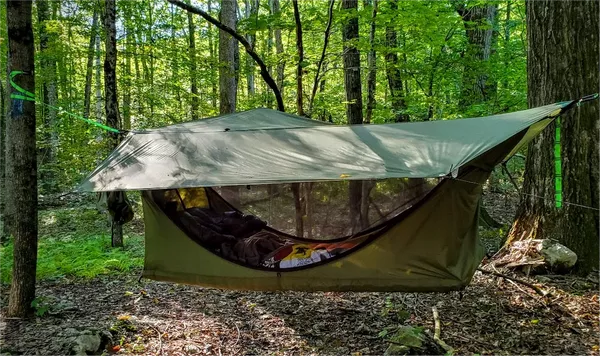Hammock camping offers a unique outdoor experience, blending the comfort of a hammock with the shelter of a tent. Whether you’re an avid backpacker, a casual camper, or simply seeking a new adventure, crafting your own hammock tent can elevate your outdoor excursions. In this comprehensive guide, we’ll walk you through the step-by-step process of creating your own hammock tent, from selecting the right materials to setting it up in the wilderness.
Materials Needed
Before diving into the construction process, gather the following materials:
1. Ripstop Nylon Fabric: Choose a durable and lightweight ripstop nylon fabric for the hammock body. Aim for a material with a denier rating between 70D to 210D for optimal strength and weight.
2. Climbing Rope or Paracord: Select high-strength rope or paracord for suspending the hammock between trees. Ensure it can support your weight securely.
3. Tarp or Rainfly: A waterproof tarp or rainfly will provide protection from the elements. Look for a material with polyurethane coating or silicone treatment for waterproofing.
4. Carabiners and Hardware: Use heavy-duty carabiners and hardware for attaching the hammock to the suspension system. Opt for materials like aluminum or stainless steel for durability.
5. Sewing Kit: You’ll need a sewing kit equipped with a heavy-duty needle and strong thread for stitching the hammock components together.
6. Insulation (Optional): Depending on the weather conditions, consider adding insulation layers such as an underquilt or sleeping pad to stay warm during chilly nights.
Step-by-Step Guide
1. Design and Measurement: Begin by designing your hammock tent. Determine the desired length and width of the hammock body based on your height and preferred sleeping position. Add a few inches to accommodate seams and hemming.
2. Cutting the Fabric: Using sharp scissors or a rotary cutter, cut the ripstop nylon fabric according to your measurements. Cut two identical pieces for the hammock body and one smaller piece for the rainfly or tarp.
3. Hemming and Reinforcement: Fold and hem the edges of the fabric to prevent fraying. Reinforce stress points such as the hammock ends and suspension loops with extra stitching for added strength.
4. Attaching Suspension Loops: Sew sturdy loops or channels at each end of the hammock to attach the suspension system. Ensure they are securely stitched to bear your weight without tearing.
5. Assembling the Suspension System: Determine the distance between trees or anchor points and cut the climbing rope or paracord accordingly. Tie secure knots such as the bowline or figure-eight loop at each end for attachment to the hammock and trees.
6. Installing the Rainfly: If using a tarp or rainfly, attach it above the hammock to provide shelter from rain and wind. Use guylines and stakes to secure the rainfly tautly and prevent sagging.
7. Testing and Adjustments: Before venturing into the wilderness, test your hammock tent setup in your backyard or local park. Make any necessary adjustments to ensure stability, comfort, and protection from the elements.
Tips for Success
1. Practice Knot-Tying: Master essential knots such as the taut-line hitch and the trucker’s hitch for securing your hammock and rainfly with confidence.
2. Choose Suitable Trees: Select healthy and sturdy trees with appropriate spacing for hanging your hammock. Avoid trees with brittle branches or signs of decay.
3. Consider Terrain and Weather: Take into account the terrain and weather conditions of your camping destination when designing and setting up your hammock tent. Ensure it can withstand wind, rain, and uneven terrain.
4. Leave No Trace: Practice Leave No Trace principles by minimizing your impact on the environment. Avoid damaging vegetation or disturbing wildlife when setting up your hammock tent.
Additional Considerations
While the basic steps outlined above will guide you through the process of making a hammock tent, there are some additional considerations to keep in mind for a successful and enjoyable camping experience:
1. Weight and Packability: When choosing materials for your hammock tent, consider their weight and packability. Lightweight and compact materials will make it easier to carry your gear during backpacking trips and ensure that your pack remains manageable.
2. Ventilation and Condensation: Proper ventilation is essential to prevent condensation buildup inside your hammock tent, especially in humid or rainy conditions. Consider adding mesh panels or vents to improve airflow and reduce moisture accumulation.
3. Bug Protection: Depending on your camping environment, you may need to incorporate bug netting or a bug bivy into your hammock tent design to keep insects at bay while you sleep. This will ensure a more comfortable and restful night’s sleep, particularly in areas prone to mosquitoes or other biting insects.
4. Modularity and Versatility: Designing your hammock tent with modular components can enhance its versatility and adaptability to different camping scenarios. Consider adding removable features such as a detachable bug net or convertible rainfly to customize your setup based on weather conditions and personal preferences.
5. Safety Precautions: Always prioritize safety when setting up and using your hammock tent. Inspect your gear regularly for signs of wear or damage, and replace any worn components to prevent accidents or equipment failure. Additionally, be mindful of your surroundings and choose secure anchor points for suspending your hammock to minimize the risk of falls or injuries.
By incorporating these additional considerations into your hammock tent design and camping preparations, you can create a versatile and comfortable shelter that enhances your outdoor adventures. Whether you’re exploring remote wilderness areas or enjoying a weekend getaway in your local park, a well-designed hammock tent offers the perfect combination of comfort, convenience, and connection with nature. So gather your gear, head into the great outdoors, and experience the joy of hammock camping for yourself!
Conclusion
Crafting your own hammock tent allows you to customize your outdoor shelter to fit your preferences and needs. By following this comprehensive guide and selecting high-quality materials, you can create a comfortable and reliable hammock tent for your next adventure. Embrace the freedom of hammock camping and experience the great outdoors in a whole new way. Happy camping!

